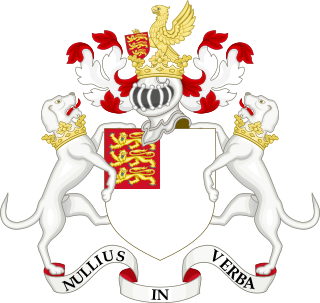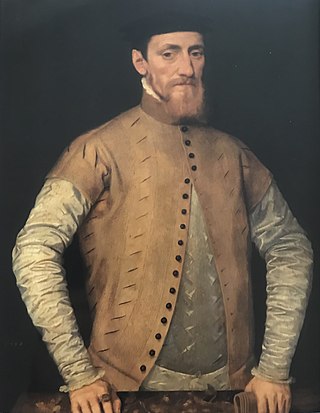Related Research Articles

The Royal Society, formally The Royal Society of London for Improving Natural Knowledge, is a learned society and the United Kingdom's national academy of sciences. The society fulfils a number of roles: promoting science and its benefits, recognising excellence in science, supporting outstanding science, providing scientific advice for policy, education and public engagement and fostering international and global co-operation. Founded on 28 November 1660, it was granted a royal charter by King Charles II as The Royal Society and is the oldest continuously existing scientific academy in the world.

William Brouncker, 2nd Viscount Brouncker FRS was an Anglo-Irish peer and mathematician who served as the president of the Royal Society from 1662 to 1677. Best known for introducing Brouncker's formula, he also worked as a civil servant, serving as a commissioner in the Royal Navy. Brouncker was a friend and colleague of Samuel Pepys, and features prominently in the Pepys' diary.
Sir Robert Moray FRS was a Scottish soldier, statesman, diplomat, judge, spy, and natural philosopher. He was well known to Charles I and Charles II, and to the French cardinals Richelieu and Mazarin. He attended the meeting of the 1660 committee of 12 on 28 November 1660 that led to the formation of the Royal Society, and was influential in gaining its Royal Charter and formulating its statutes and regulations. He was also one of the founders of modern Freemasonry in Great Britain.

William Croone was an English physician and one of the original Fellows of the Royal Society.

Sir John Gresham was an English merchant, courtier and financier who worked for King Henry VIII of England, Cardinal Wolsey and Thomas Cromwell. He was Lord Mayor of London and founded Gresham's School. He was the brother of Sir Richard Gresham.

Henry Brouncker, 3rd Viscount Brouncker was an Anglo-Irish peer, courtier and politician. He served as Cofferer of the Household to Charles II, and served as Gentleman of the Bedchamber to James, Duke of York. He was a member of parliament and a very skilled games player.
Walter Pope was an English astronomer and poet. He was the son of Francis Pope and Jane Dod, daughter of the Puritan minister John Dod. He was born in Northamptonshire and was the half brother of John Wilkins, who would become bishop of Chester and one of the founders of the Royal Society. He was educated at Wadham College, Oxford, with a BA in 1649, MA in 1651. Until the Restoration, he worked in Wadham College.
Sir Gilbert Roberts was a British civil engineer who designed many famous bridges worldwide.
William Neile was an English mathematician and founder member of the Royal Society. His major mathematical work, the rectification of the semicubical parabola, was carried out when he was aged nineteen, and was published by John Wallis. By carrying out the determination of arc lengths on a curve given algebraically, in other words by extending to algebraic curves generally with Cartesian geometry a basic concept from differential geometry, it represented a major advance in what would become infinitesimal calculus. His name also appears as Neil.
The post of Lord President of Munster was the most important office in the English government of the Irish province of Munster from its introduction in the Elizabethan era for a century, to 1672, a period including the Desmond Rebellions in Munster, the Nine Years' War, and the Irish Rebellion of 1641. The Lord President was subject to the Lord Deputy of Ireland, but had full authority within the province, extending to civil, criminal, and church legal matters, the imposition of martial law, official appointments, and command of military forces. Some appointments to military governor of Munster were not accompanied by the status of President. The width of his powers led to frequent clashes with the longer established courts, and in 1622 the President, Donogh O'Brien, 4th Earl of Thomond, was warned sharply not to "intermeddle" with cases which were properly the business of those courts. He was assisted by a Council whose members included the Chief Justice of Munster, another justice and the Attorney General for the Province. By 1620 his council was permanently based in Limerick.

Titsey Place is an English country house near Oxted in Surrey, England. It was successively the seat of the Gresham and Leveson-Gower families and is now preserved by a charitable trust for the nation.
Sir Paul Neile FRS was an English astronomer and politician who sat in the House of Commons in 1640 and from 1673 to 1677.
Robert Shippen D.D. FRS (1675–1745) was an English academic administrator at the University of Oxford.

The Gresham College group was a loose collection of scientists in England of the 1640s and 1650s, a precursor to the Royal Society of London. Within a few years of the granting of a charter to the Royal Society in 1662, its earlier history was being written and its roots contested. There is still some debate about the effect of other groups on the way the Royal Society came into being. The composition of those other groups is unclear in parts; and the overall historiography of the early Royal Society is still often regarded as problematic. But this group has always been seen as fundamental to the course of events.
References
- ↑ "Fellows of the Royal Society", Royal Society. "Fellowship from 1660 onwards" (xlsx file on Google Docs via the Royal Society)